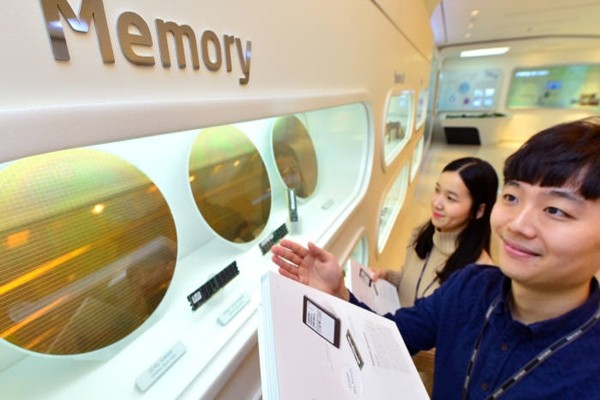Amount of Samsung Electronics’ investment into semiconductor facilities this year is calculated to be more than the amount of investments from Intel, which is the world’s top system semiconductor business, and TSMC, which is the world’s top foundry business. As Samsung Electronics has carried out its biggest facility investment this year, there are growing concerns towards possibility of oversupply of memories. Industries are beginning to believe more and more that Samsung Electronics is changing its strategy from making investments based on profitability to making investments in order to increase shares of memory markets through so-called ‘chicken game’.
Market research company called IC Insights is estimating that amount of Samsung Electronics’ investment into semiconductor facilities this year will be around $26 billion. This amount more than doubles its investment from last year ($11.3 billion). Samsung Electronics announced that it will be investing $26.6 billion (29.5 trillion KRW) this year just for its semiconductor business during its conference call for its third quarter performance. IC Insights is estimating that total amount of facility investments made by global semiconductor industries this year will be around $90.8 billion, which is 35% increase compared to the amount of last year’s investments. This indicates that amount of Samsung Electronics’ investments corresponds to whopping 28.6% of total amount of facility investments made by global semiconductor industries.
“Amount of Samsung Electronics’ investments this year is unheard of in 37 years of semiconductor industries.” said CEO Bill McClean of IC Insights with emphasis.
IC Insights analyzed that Samsung will be investing $14 billion into 3D NAND flash memories, $7 billion into DRAMs, and $5 billion into foundries and others this year. IC Insights is predicting that Samsung Electronics will use its investment for 3D NAND flash memory will be used to increase production capacity of its new facility in Pyeongtaek. It is also predicting that Samsung Electronics’ investments for DRAM and foundry will be used to upgrade process nodes and supplement loss from wafer inputs (increase in number of processes) and to increase production of 10-nano semiconductors respectively.
“This large-scale investment made by Samsung Electronics will cause oversupply of 3D NAND flash memories.” said IC Insights. “This will incite investments from other competitors such as SK Hynix, Toshiba, Micron, and Intel.” This indicates that semiconductor businesses will either increase amount of their investments or lose their market shares.

IC Insights analyzed that Samsung Electronics’ large-scale investment will stifle hopes of Chinese businesses that are looking to enter NAND flash memory or DRAM markets. “Looking at the size of Samsung Electronics’ investments this year, it will be difficult for new Chinese memory manufacturers to compete with Samsung Electronics unless they form joint companies with current memory manufacturers.”
While IC Insights focused on 3D NAND flash memory, Taiwanese market research company called TrendForce previously referred to a report made by The Electronic Times (First page of its newspaper issued on 10/31/17 with a title ‘Samsung Looking to Expand Supplies of DRAMs’) and analyzed that there might be oversupply in DRAM markets as well.
“Samsung Electronics is planning to increase its output of DRAMs in order to make entry barrier higher.” said TrendForce. “It is planning to stop price from going up even higher.” Samsung Electronics converted part of its 16 line in Hwasung for producing DRAMs and decided to also produce DRAMs from second floor of its new facility in Pyeongtaek. Merrill Lynch also published its report earlier this month and estimated that Samsung Electronics’ monthly production capacity of DRAM will increase by 20% within 2 years.
Most of industries predict that booming of memory markets will continue until first half of 2018 and go down starting from second half. General opinion is that booming of memory markets will be ‘difficult’ in 2019. Samsung Securities and KB Investment & Securities recently changed opinions of SK Hynix’s investments from purchase to ‘postpone’.
“Although Taiwanese market research company put out a prediction early this year of oversupply, its prediction is not true after looking at results.” said Kim Young-woo who is a senior researcher for SK Securities. “Because level of difficulty of every DRAM and 3D NAND flash processes has gotten higher, amount of increase in supply is not much even if one makes large amount of investments and there should not be any worries for oversupply as number of demands for memories of Cloud infrastructures is starting to get bigger.” He also added that Samsung Electronics is currently not in a state to increase its supplies by lowering its profits.
■Trend of amount of Samsung Electronics' investments into semiconductor facilities
▲Year ∆2010: $10.9 billion ∆2011: $11.7 billion ∆2012: $12.3 billion ∆2013: $11.6 billion ∆2014: $13.5 billion ∆2015: $13 billion ∆2016: $11.3 billion ∆2017: $26 billion
Reference: IC Insights
Staff Reporter Han, Juyeop | powerusr@etnews.com